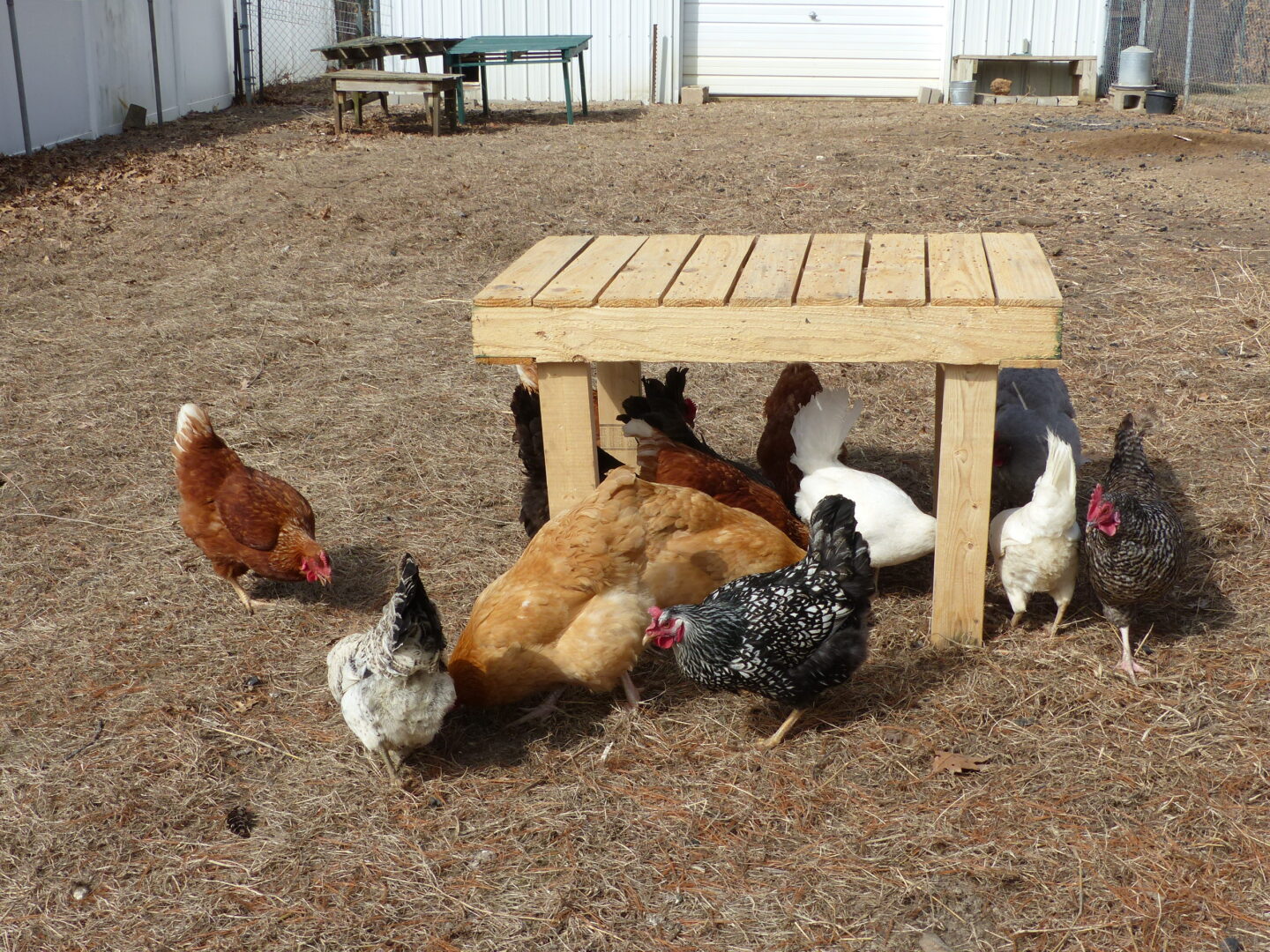Crafting a Chicken Ramada

Although winter’s subzero cold stresses people and animals, the blistering summer heat is usually a greater threat to lives and health. Wise chicken keepers prepare their coop and run to be comfortable and safe during the July and August inferno.
Keeping chickens cool during the hot months involves providing shade, water, and a breeze.
Water
Panting causes increased evaporation that helps chickens cool their bodies. During summer they’ll drink plenty of water, so placing several founts or buckets of cool, clean water scattered about the run and coop allows them to frequently drink without a long walk. Water fouls quickly in hot weather, so replacing stale water with fresh water is a daily summer task.
Breeze
Chickens love a cool breeze during hot waves. Resting in the shade under a ramada lets a breeze coming from any direction cool them during the day. Like people, chickens enjoy a cool night time breeze while they sleep. Coop windows positioned to allow cross ventilation help keep sleeping birds comfortable through the night. Make sure that open windows or doors are covered with heavy duty wire mesh to repel raccoons and insect screening to keep gnats and skeeters outside.
Shade
Backyard chickens lucky enough to have a large, sunny outdoor run love to sit in the shade on hot days. If they are lucky, the run has several shrubs that protect them from sunshine. A simple ramada provides that shade if shrubs are absent. A chicken ramada is not a fancy motel. It’s a structure easily made from a discarded pallet. In the hot sunny southwest people traditionally built an open sided structure of sticks that lets the breeze in while sheltering people from the blazing sun. A chicken ramada does the same.
Chickens love spending time outdoors in a spacious run. It’s a place for them to socialize, relax and discover tasty seeds and insects to eat. Unfortunately, the outdoors can be a dangerous place.
Two hazards are common. One is the blazing summer sun that can be lethal if birds can’t find cool shade and water. The other is overhead predators, usually hawks, that occasionally swoop down seeking a tasty chicken dinner.
Building a Ramada
A chicken ramada shields birds from heat and raptors. A simple one can be made for less than $1.00 in about an hour, even by people lacking fancy carpentry skills.

Step 1: Find three free pallets. Some two billion pallets are in daily circulation around the world. Many are used only one time and then discarded. Stores and factories often pile pallets out back to be hauled away and disposed of. It costs them money to get rid of them, so often simply asking the store or factory manager for permission to remove a few brings and enthusiastic, “Yes!” Before picking up a pallet inspect it carefully. Most will be stamped with the letters HT. This means the pallet was placed in a massive oven and HEAT TREATED…..baked to kill any insects or weed seeds that might be lurking on it. Pallets with this marking are safe to handle. Occasional, pallets might be marked MB or have a tag saying they’ve been chemically treated to kill pests. Leave them alone! They aren’t safe for either people or chickens. Bring three heat treated pallets home and place them on a level surface.

Step 2: Using a hammer, pry bar, and nail puller, carefully disassemble two of the three pallets. Often pallet wood splits easily, so pry slowly and carefully to keep the boards intact. Most pallets are made of 1/2 to 3/4th inch thick boards nailed to 2X4s. You’ll need four 2X4s 24″ long and one intact pallet to make the ramada. Save the 2X4s from the disassembled pallets and use the other boards for fireplace kindling or projects around the coop.
Step 3: Cut the 2X4s to 24″ and use a screw gun to attach them to the bottom corners of the pallet that was not disassembled. Nails work if no screw gun is available. Buying screws or nails is the only cost of this project. Basically, a chicken ramada is a table-like structure with the 2X4s forming the legs and the intact pallet the surface. The length of the legs isn’t critical and can be anywhere from 18″ to 36″ long.
Step 4 (optional): Paint the new Ramada or coat it with a wood preservative.
Step 5: Place it in the chicken run. Try to position it as close to the middle as possible. This will prevent adventuresome chickens from flying out of the coop. Some chickens will flap up to the ramada and use it as a launching pad to fly over a fence that they wouldn’t otherwise have enough wing power to clear. If the ramada is a ways from the fence they won’t have the strength to escape.
A ramada made from a recycled pallet has spaces between the boards that allow some sunlight to filter to the ground, but mostly it casts a cool shade that chickens loiter in on hot days. Often, they also like perching on top.
Chickens instinctively recognize that danger sometimes comes from above. They have excellent vision and a few birds in the flock constantly scan the sky for danger. Should a raptor or crow fly over they’ll give a warning call, sending the flock scurrying for safety under the ramada.
Summer’s heat isn’t far away. Comfortable chickens are productive birds and providing water, shade, and breezes keeps them safe.
